Vinegar Syndrome October releases, part two
Strictly speaking, the first two disks here don’t qualify as Vinegar Syndrome October releases – the first comes from one of their partner labels, while the second is an older catalogue title – but I did receive them in the same package!
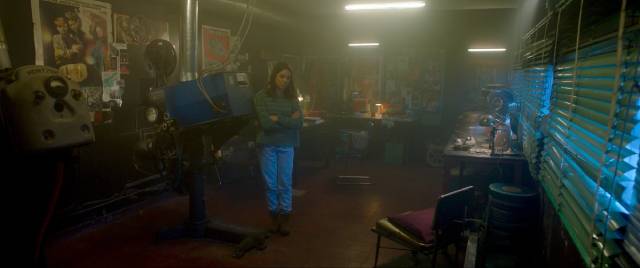
in Maximiliano Contenti’s The Last Matinee (2021)
Al morir la matinée (Maximiliano Contenti, 2021)
I really wanted to like Maxi Contenti’s homage to Italian horror and the giallo, and Al morir la matinée (The Last Matinee, 2021) gets a great deal right stylistically … but there’s a central flaw which kept me at an irritated distance. Claiming origins in an urban legend, the film is set on a rainy evening in Montevideo, Uruguay, in 1993. The Opera movie theatre is showing a horror film (time is apparently fluid, because the movie on screen is Ricardo Islas’s Frankenstein: Day of the Beast, which was released in 2011), but the final screening of the day is sparsely attended because of the storm. (Another quibble – it’s late evening, so definitely not a matinee; guess “the last picture show” was already taken!)
Up in the booth, student Ana (Luciana Grasso) chastises her overweight, chain-smoking father for agreeing to work a double-shift as projectionist and sends him home in a taxi, taking on the task of running the projectors herself while she studies for an upcoming test. Down in the auditorium, there’s a cranky old man, a nervous guy who has scored a date with a woman who views him with amused disdain, a young boy hiding from the usher, three friends, one of whom is obsessed with a woman he saw on the bus, and finally that woman, who comes in alone, triggering some debate about whether the guy should approach her and risk coming across as a creep.
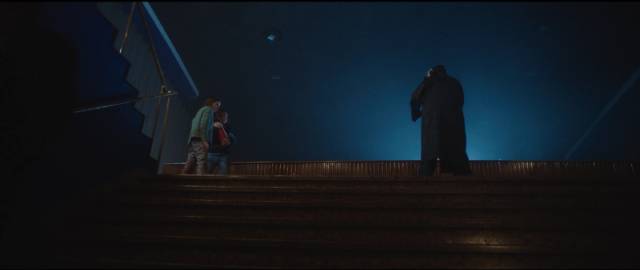
Then there’s one more man, a hulking figure carrying a big bag, whom we first glimpsed in his car fishing in what looks like a big pickle jar, popping something moist and crunchy into his mouth. This guy (played by Ricardo Islas, director of the film-within-the-film) slips in after the show has started and gradually stalks the other patrons, killing them one by one. Contenti is going for something along the lines of Lamberto Bava’s Demons (1985), though on a quieter, more subtle scale. As the patrons watch on-screen horrors, voyeurs enjoying the pain and suffering of the movie’s characters, they are becoming victims themselves of even worse horrors. This strange psychological connection between watching and being has interested filmmakers almost since the beginnings of cinema – it’s there in Buster Keaton’s Sherlock Jr. (1924), it’s the basis of one of Hitchcock’s greatest films, Rear Window (1954) – prompting us in turn to examine our own position in relation to what we are watching.
With so few potential victims, Al morir la matinée doesn’t explode into the chaos of Demons; it remains quieter and more intimate, with each death lingered over, calling attention to our voyeuristic interest in the pain and terror of the audience within the film. All of this is handled with skill, lushly photographed by Benjamin Silva. But for me it is repeatedly undermined by the script.
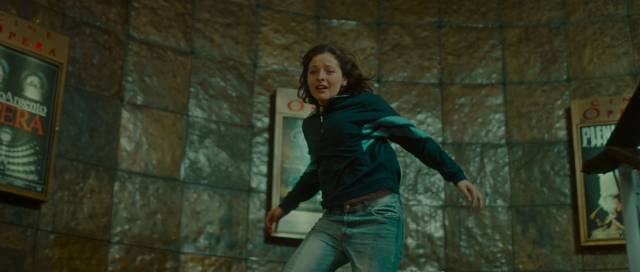
Ana is initially set up as smart, self-assured, forceful. She handles her father like an experienced caregiver; she wards off the annoying attention of pushy usher Mauricio (Pedro Duarte); she handles the unwieldy 35mm projectors without fear, even repairing broken film quickly and efficiently. So why is she inexcusably dumb when it really matters?
Having noticed something odd down in the auditorium, she goes to take a look and discovers fresh blood in several places. At which point, the logical thing to do would be to turn off the movie, turn up the lights, tell the few remaining customers to head for the exit, and call the police.
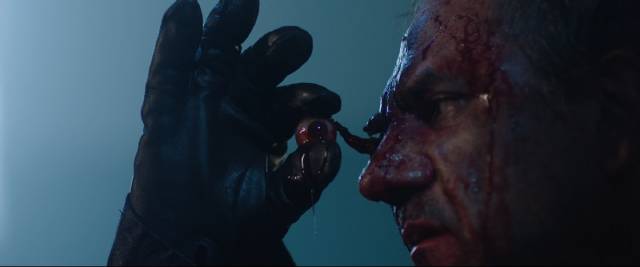
But instead she goes back to the booth … and returns to studying her textbook. And even after the shit really hits the fan, she makes baffling choices. Cornered in the booth with the two remaining live customers, the young boy and the young woman whose two companions are now dead, she discovers that the phone is dead as the killer is hammering on the door. When he breaks in, she and the other woman fight back, temporarily disabling him. The boy flees the booth and Ana, rather than bearing down and finishing off the stunned killer, runs after the boy, even though he’s now out of immediate danger, leaving the young woman in the booth as the killer recovers and finishes her off. Ana’s decisions get people killed. But there’s no indication that the film is aware that as a heroine, a supposedly intelligent final girl, she sucks. There’s no real sense of triumph when she does finally defeat the killer because of the fatal errors she has made along the way.
So I was disappointed, and yet the disk (released by VS partner label Dark Star) is so ridiculously overstuffed with extras that I still got more than my money’s-worth. The feature gets a director’s commentary, there are several background featurettes, seven of Contenti’s short films, a music video, some storyboards – and two additional features.
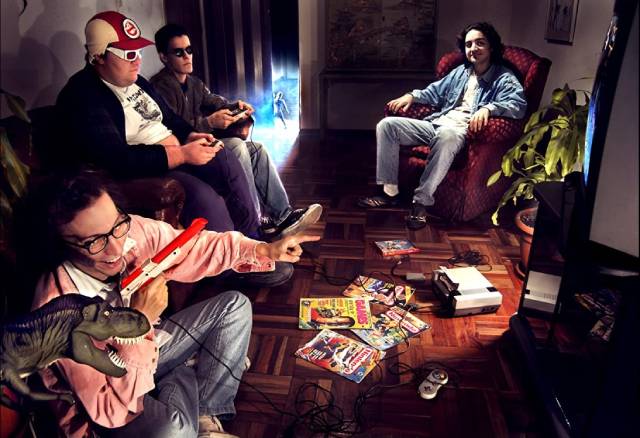
Contenti’s earlier feature Muneco viviente V (Puppet Pal V, 2008) is a mess, but stuffed with wildly imaginative elements. Bruno (Bruno Contenti) is home from school when his parents tell him they’re going away and he’s on his own; they won’t give him any money because they’re sick of supporting him, and there’s no food in the house. He calls his friends, telling them he’s throwing a party and they should each bring food. They come over and play video games … but there’s a problem. Ever since childhood, Bruno has been haunted by a malevolent toy, a G.I. Joe-type doll which he has done everything to destroy. It has one eye cut out, its body is scarred and burned, and yet it continues to stalk him. Back again, it kills off his friends one by one. And when his father returns, but with a new wife, it takes care of them too and in the end, it seems that the killer doll has maybe been trying to liberate him from a miserable life.
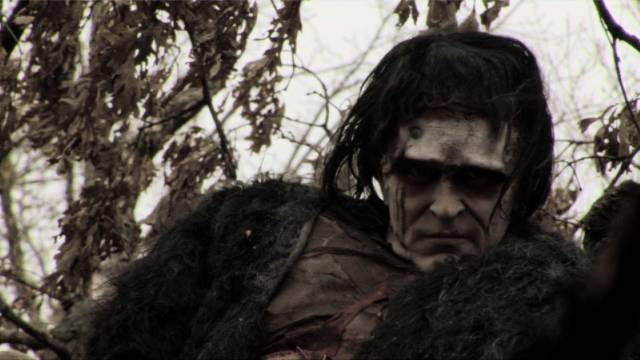
The second bonus feature is none other than Frankenstein: Day of the Beast, looking much better than the faded version seen in The Last Matinee. I actually ended like liking this one best of the three. Obviously very low budget, with a confusing sense of period and location, it focuses on two brief sections of Mary Shelley’s novel, but strips them of her philosophical intentions. Here, the creature built by Frankenstein has no language and is driven by raw emotion and instinct. In the opening section, it hangs around the remote winter-bound cabin of the blind man (Bruce Spielbauer); rather than learning to speak, he observes the family’s relationships as the son returns with his new wife. The creature (Tim Krueger) savagely kills everyone, possibly raping the women, leaving the mess as a warning to Frankenstein, who is on his trail.
Frankenstein (Adam Stephenson) understands the message and quickly goes to a remote island where he organizes a rushed marriage to his fiancee Elizabeth (Michelle Shields) with an unsavoury group of mercenaries watching over them. The creature shows up and the slaughter begins; when Frankenstein finally tells everyone what he’s done and why the monster is attacking, the mercenaries turn against him and seize Elizabeth, intending to hand her over. Even though she manages to get away from them, the creature does catch up and rape her, hoping she’ll conceive his offspring. Understanding this, she kills herself and Frankenstein naturally uses his methods to try and bring her back…
While the movie often resembles a community theatre production, performed with more enthusiasm than skill, writer-director Islas manages to breathe some fresh life (sorry) into the much-adapted story. It’s certainly not Shelley’s Frankenstein, but it follows its own interpretation to a logical conclusion, which in itself is quite satisfying.
*
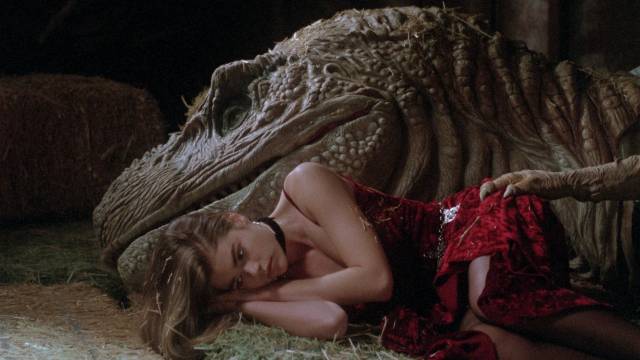
Tammy and the T-Rex (Stewart Raffill, 1994)
Stewart Raffill isn’t exactly a name to conjure with, though I do recall liking High Risk (1981) when I saw it forty years ago. The Ice Pirates (1984) is cheesy and dumb, while The Philadelphia Experiment (also 1984) may be his best movie, a smaller, low-budget riff on themes from Don Taylor’s The Final Countdown (1980). Even when I was going to the theatre to see pretty much everything that was being released, I couldn’t bring myself to watch Raffill’s Mac and Me (1988), a blatant E.T. clone notorious for its ubiquitous product placements. But at the suggestion of a friend I did decide to take a chance on Tammy and the T-Rex (1994, for some reason given the on-screen title Tanny and the Teenage T-Rex), a movie with such a ridiculous concept that I hoped to be entertained.
When cheerleader Tammy’s boyfriend is killed, a mad scientist puts his brain in a full-size robotic dinosaur and when he manages to convince Tammy it’s really him, they resume their relationship as the authorities close in and try to destroy it. With that baseline, there are probably numerous directions the movie could take – and that’s ultimately the problem. It’s all over the place tonally so it’s unclear what reaction Raffill was aiming to provoke.
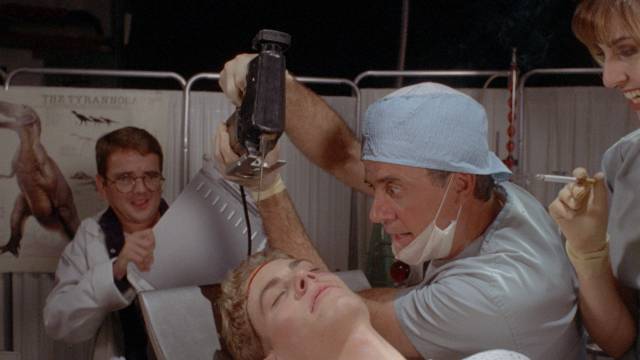
The opening section is a typical high school movie. Tammy (Denise Richards) has fallen for nice guy Michael (Paul Walker), but things are complicated because her previous boyfriend Billy (George Pilgrim) is a total psychopath who asserts ownership of her and threatens to kill Michael if he doesn’t stay away. These early scenes are played fairly straight and Billy is convincingly menacing. After Michael visits Tammy again, Billy and his friends kidnap him and dump him at night in a game park, where he’s mauled by the big cats and ends up in a coma. But amidst all this teen angst drama, we’ve also been introduced to Dr. Wachenstein (Terry Kiser) and his team, who have built the robotic T-Rex, which is controlled by a computer operated by one of the doc’s assistants (Children of the Corn’s John Franklin). Somehow, this is all for the good of mankind.
In comparison to the high school stuff, the scientist’s storyline is played for extremely broad, slapstick comedy. In fact, the performances of Kiser and Ellen Dubin as his “assistant” Helga wouldn’t be out of place in a porn parody – they seem about to fuck at any moment, wherever they are and whatever they’re doing. I was frequently reminded of Flesh Gordon (Michael Benveniste & Howard Ziehm, 1974). Looking for a brain to put into the T-Rex, the Doc hears about Michael, goes to the hospital, fakes his death, and steals the “body”. Even though, back at the lab, Michael wakes up as the top of his head is cut off, the Doc proceeds, intending to lobotomize the newly installed brain to make it more pliable once it’s settled in.
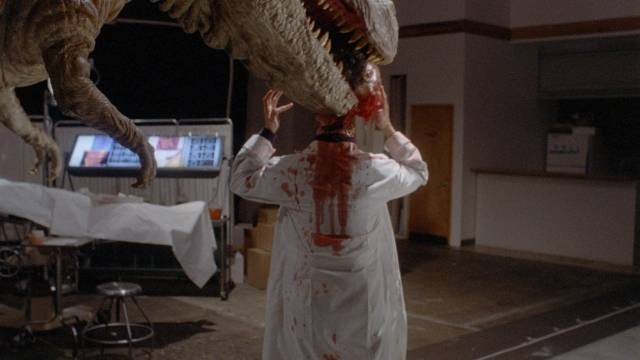
But before he can do that, Michael kills two assistants – by biting off a head and stomping flat – and escapes from the lab. He finds his way to a party, where Tammy seems a bit down but hardly in deep mourning for her dead boyfriend. The mix of teen angst and slapstick comedy becomes more confusing as Michael starts killing kids at the party – biting off limbs, crushing people under cars, tearing off heads – all done with fairly graphic gore. He also kills Billy, a major miscalculation from a dramatic standpoint, removing the primary antagonist halfway through the story instead of saving him for a final showdown.
As the cops try to figure out what’s going on and Wachenstein tries to get the dinosaur back under his control, Michael kidnaps Tammy and manages to convince her that he really is still alive and stuck inside the robot. She and her gay Black friend Byron (Theo Forsett) try unsuccessfully to convince the cops (including Byron’s dad, the Sheriff) that the T-Rex is Michael, and the authorities blow it to pieces with gunfire – not without reason, since it’s killed quite a few people. A brief coda reveals Michael’s brain still alive in Tammy’s bedroom, hooked up to a camera which enables him to watch her do a striptease which climaxes with his brain orgasm…
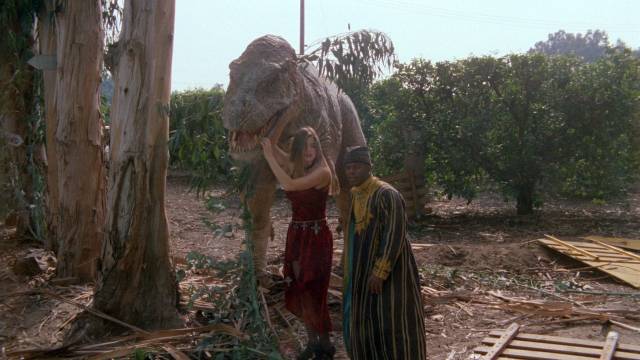
Although production values are good, with the big animatronic dinosaur actually managing to express some emotion, the graphic gore, the dumb comedy and the teen romance never gel into anything coherent. Maybe a better director than Stewart Raffill could have found a way to make it work, but as it is it’s a collection of tonally disparate bits and pieces notable for its use of animatronics a year after Jurassic Park (1993) more or less sealed the fate of practical effects by proving what could be done with CGI – and for the presence of Richards and Walker in lead roles very early in their careers.
*
Camille Keaton in Italy (1972-74)
Camille Keaton, reputedly a distant cousin of the great Buster, achieved notoriety when she starred as aspiring writer Jennifer Hills in Meir Zarchi’s notorious I Spit on Your Grave (1978), the unparalleled pinnacle of the rape-revenge genre. But before that, she had moved to Italy in hopes of jump-starting a film career. Having worked as a model, she managed to land a couple of bit parts, and then was cast by Massimo Dallamano in the small but pivotal title role in What Have You Done to Solange? (1972). Over the next couple of years, she appeared in several more Italian movies, including the three collected by Vinegar Syndrome in their Camille Keaton in Italy box set.
While none of these features is great, they are interesting genre exercises and Keaton displays genuine screen presence in all of them. Her slight build and delicate features give her an air of vulnerability, but she also suggests reserves of inner strength – a combination which served her well when she returned to the States and took the role in Zarchi’s film. In some ways, she reminds me a little of Mimsy Farmer – a pity no one ever thought to cast them together, with Camille as Mimsy’s more fragile sister.
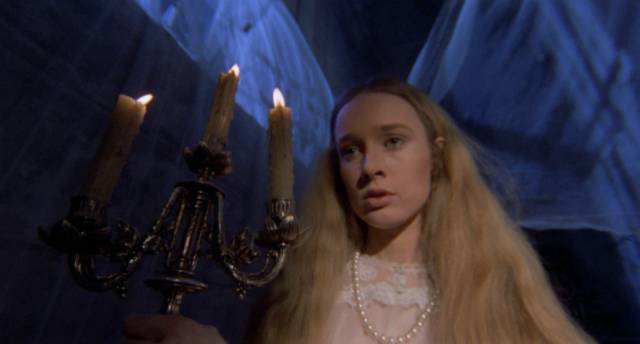
Tragic Ceremony (Riccardo Freda, 1972)
Tragic Ceremony, or Estratto dagli archivi segreti della polizia di una capitale europea (1972), was pretty much the end of Riccardo Freda’s three-decade career (he made only two more movies at the end of the ’70s), and it’s far from his best work. Even that Italian title sounds weary – Extract from the secret police archives of a European capital – lacking the absurdly vivid imagery of the title of the movie he had made the previous year, The Iguana With the Tongue of Fire (1971). Co-written by Mario Bianchi, whose own movies tended towards the sleazier end of the exploitation spectrum, the script throws in a lot of random elements that never really cohere, although Freda does occasionally conjure up a striking visual – Keaton’s midnight descent of a long stone staircase lit by candles; a sudden shocking moment of violence as a man’s head is split in half by an axe – but there’s not much in the way of a story to hold audience attention.
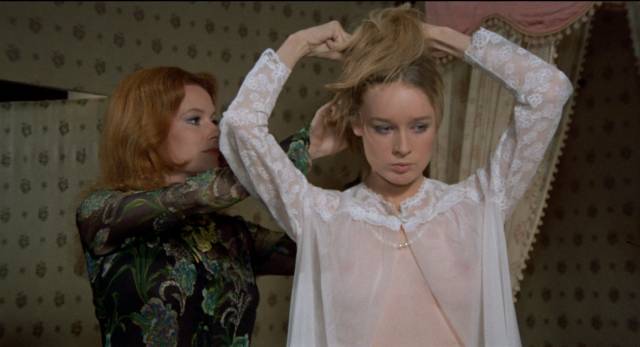
Keaton is out for a day of sailing and sunbathing with three men, two of whom make little attempt to conceal their contempt for the third, a rich guy who they keep around just to sponge off. Heading home late in their dune buggy, they run out of gas but manage to find an out-of-the-way service station whose unfriendly owner gives them just enough to get to the next town. But they get lost and run dry again at the gates of a country estate. Allowed in by the not very hospitable owners, they settle in for the night.
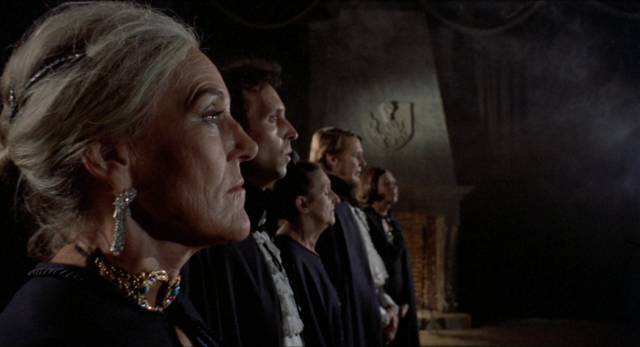
Keaton’s Jane is woken by strange sounds and descends into the depths of the mansion where she finds their hosts presiding over a Black Mass. It turns out that she’s to be the night’s sacrifice to Satan, but just before the ceremonial dagger is plunged into her heart, her friends interrupt and everything explodes into inexplicable violence as the Satanists are overcome by a frenzy which makes them turn on each other. Jane and her friends escape the mayhem and head home. The rich guy’s mother kicks them out because she’s having an at-home with her lover, and they retreat to the family summer place, hearing news reports that the police are searching for a gang of hippies who have massacred an aristocratic couple and their guests. Funny thing is, their host’s wife has disappeared, though it’s presumed that she’s also dead…
It’s not a huge surprise to discover that Jane’s strange behaviour is due to being possessed by the woman who had been about to sacrifice her. The demonic couple played by Luigi Pistilli and Luciana Paluzzi manage to make an impression despite the brevity of their roles; otherwise, Keaton is the only notable presence among a fairly lacklustre cast.
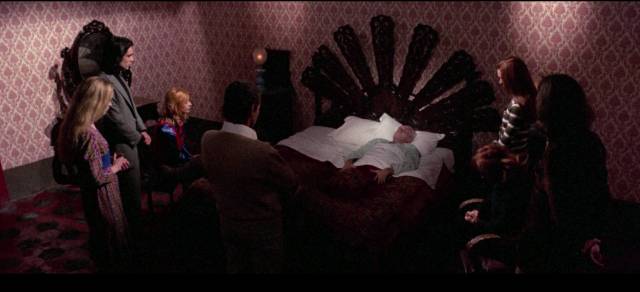
in Angelo Pannaccio’s Sex of the Witch (1973)
Sex of the Witch (Angelo Pannaccio, 1973)
Made the following year, Angelo Pannaccio’s Sex of the Witch (Il sesso della strega, 1973) is considerably sleazier, with long stretches of soft-core sex padding the running time of a rather thin narrative. A family gathers as the patriarch lies dying, all waiting to know what he’s going to bequeath them. Naturally, he despises them all and has designed his will to cause as much trouble as possible. One, Evelin (Jessica Dublin), is completely disinherited; the others all get equal shares – and if any of them happen to die, their portion will be divided among the rest. The “witch” Evelin owns a shop which sells occult supplies and although it’s not immediately clear, a visit from Ingrid (Annamaria Tornello) shortly after the patriarch’s death sets events in motion; soon members of the family are being killed off in various violent ways, catching the attention of a police commissioner (Donald O’Brien, Dr. Butcher himself), who hangs around as the characters make out like rutting rabbits between the killings.
Keaton is relegated to a secondary role among the ensemble, though she manages to stand out in a few moments. Pannaccio seems more interested in the sex than the mystery and despite attractive locations nicely shot by cinematographers Maurizio Centini and Girolamo La Rosa the movie doesn’t have much tension or pace.
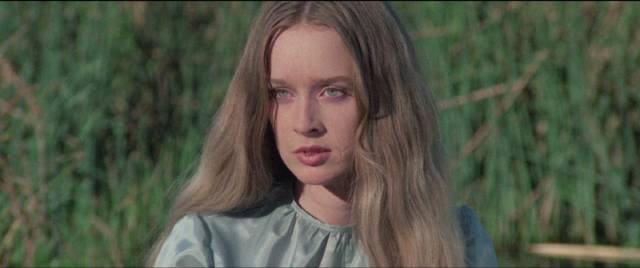
Madeleine, Anatomy of a Nightmare (Roberto Mauri, 1974)
The third movie in the set was also Keaton’s final Italian production before she returned to the States. Not only does Roberto Mauri’s Madeleine, Anatomy of a Nightmare (Madeleine, anatomia di un incubo, 1974) provide her biggest role to date, and an opportunity to stretch her acting skills, it belongs in a different class than the previous two features. Rather than Gothic horror, it has its roots in the genre of female psychological derangement, something akin to Robert Altman’s Images (1972), more ambitious and experimental than the previous movies. As in Altman’s film, dream and reality become increasingly difficult to distinguish and the audience is trapped in the subjective perceptions of a mind which has lost its grip on reality. Who that character is and what her relationships to the people around her are seem to be shifting constantly.

The film opens with Madeleine (Keaton) pregnant and running through woods, pursued by a group of women with hair died in various bright colours. As they close in, we see a crashed and burning car, a child’s doll caught in the flames. Madeleine wakes in a lounge chair on the lawn of a villa, a man sitting near her reading a large book with “parapsychology” printed on the cover. This man, Franz (Silvano Tranquilli), is presented variously as Madeleine’s husband, her lover, a doctor, his identity shifting according to what she’s doing at any particular time.
Madeleine picks up Thomas (Pier Maria Rossi), a hitchhiking student, and brings him back to the villa where she entices him into the swimming pool, followed by a bout of lovemaking in the living room with Franz watching through a spy hole in the wall. As things gradually unfold, it seems that Madeleine is dealing with the trauma of a miscarriage, which Franz is trying to help her work through – the birth of a colt in the villa’s stable takes on significance in light of this. Franz’s son, race car driver Luis (Riccardo Salvino), comes to visit from Paris and she becomes sexually involved with him as well.
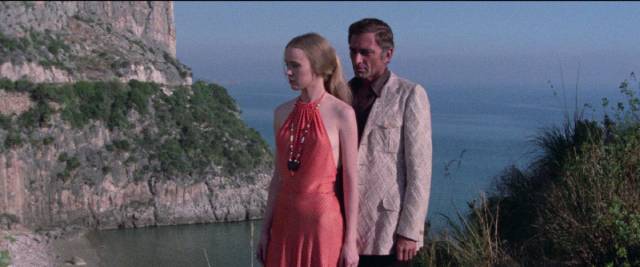
After a climactic confrontation ending in violence, everything is changed by a final sequence which redefines all the characters and their relationships. This twist reveals that everything we’ve seen has been shaped by the mysterious female derangement rooted in a sexuality which is almost incomprehensible and threatening to men. As in Altman’s Images, men can never really know women and therein lies danger – which is a problematic position and obviously one shaped by a male point of view. But it nonetheless provides actresses with roles which they can tear into with relish; Keaton here gives a performance which can stand with Susannah York’s in Altman’s film.
*
All three movies look excellent, having been scanned from the original negatives (the first two in 2K, Madeleine in 4K). Tragic Ceremony and Sex of the Witch offer only Italian dubs, having apparently never been prepared for English-language markets, while Madeleine does have an alternate English dub. Each film gets a commentary, by Samm Deighan, Kat Ellinger and Keaton respectively, and there are on-camera interviews with Keaton on the first and last disks, plus an audio essay by film historian Rachael Nisbet on the Madeleine disk. All in all, the set is a good introduction to a major aspect of the career of an actress generally known for just one single movie.
*
With this weekend’s Black Friday sale, there’ll be a new influx of disks from Vinegar Syndrome and their partners in the next couple of weeks (plus a fresh bundle from Severin) … it almost feels like they’re all I need to keep my viewing schedule full!
Comments